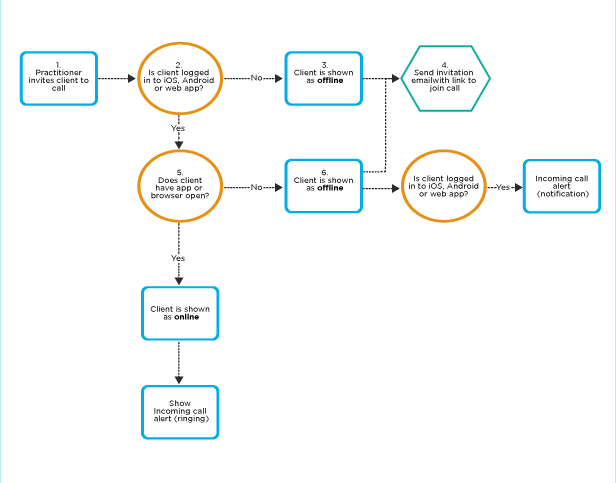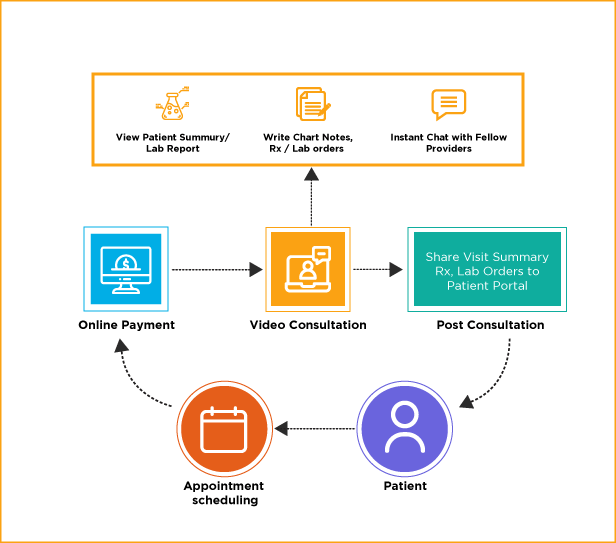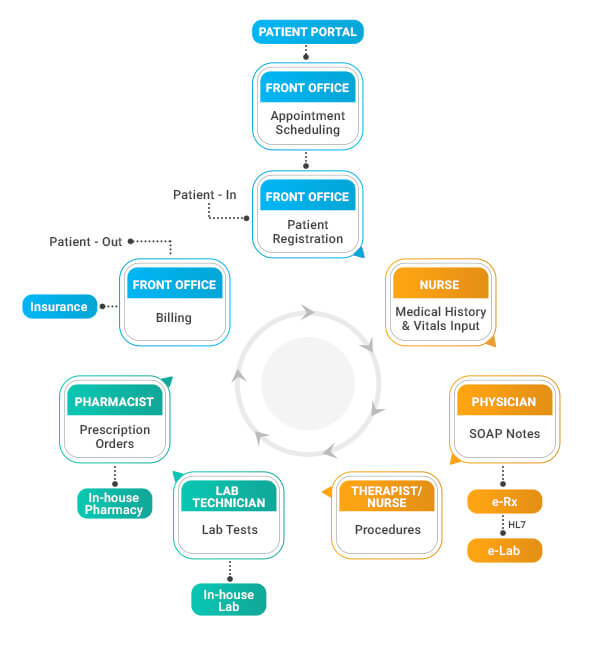Telehealth technology with optimized workflow mapping can streamline health information exchanges. Therefore, the importance of workflow in healthcare for targeted care delivery is essential for healthcare providers.
As a result of the pandemic, many healthcare practices are compelled to adopt telehealth as soon as practicable. Therefore, healthcare providers did not have enough time to explore the optimal long-term Integrated Physician workflow thoroughly.
According to the US Department of Health & Human Services, Workflow is the set of physical and mental activities undertaken inside and across the workplace environment by different individuals. It can happen at multiple levels (one person, between individuals, through institutions) and can happen sequentially or concurrently.
Telehealth platforms will help the healthcare staff rapidly catch the reason for the call or appointment to each patient. They will prioritize care delivery, recommend the right directives for treatment, and recognize additional information sources.
Thus, healthcare providers will get the opportunity to use their resources better to serve more patients and provide the highest quality treatment. Consider some recommendations to refine the telehealth workflow to render the possible use of telehealth technology:
Plan Ahead Your Telehealth Workflow

You have now invested time, resources, and capital in the new processes and healthcare cloud computing. Your telehealth approach should plugin and operate directly with those networks that are already in operation, not outside them.
With telehealth technology, digital visits can be almost as effective, if not more than an in-person visit to the workplace. The more telehealth software systems that integrate, the less stress the practice and practitioners need to manage patient flow and patient information management.
Why not, for example, integrate your practice management solutions with your telemedicine solutions? Submit automatic appointment updates based on a clinical calendar, make a virtual visit, and reimburse for a session, all from one location.
Yeah, it is correct that the regulation of HIPAA compliance has been temporarily eased in these unusual circumstances. But the analysts don’t expect it to last. Plus, why bet on the privacy of your patient’s personal health information (PHI) because there are other choices?
Telehealth technology strives to develop innovative solutions; the clinicians realize the importance of workflow optimization for every long-term approach to minimize future uncertainty and financial risk.
Prepare Your Healthcare Staff

Your workers can be more secure in the latest workflow if they can plan ahead of time. Get the preparation assistance company. The agency would understand how to prepare for the modified workflow, providing recommendations that suit your institution’s unique needs. If everybody is well trained, the margin of error will decrease.
Until the system runs, you will be less likely to face difficulties. It is doable to use the time saved via Telehealth Technology for training hospital staff.
Speak to the staff on whether you’re going to be available for telehealth appointments. Discuss patient scheduling system, online patient scheduling, and how to access the information you need for each patient visit.
Clarify who will be the first to meet the patient as they join the visit. E.g., you might want a medical assistant to ask any initial questions before you enter a video call. Having a proper action plan will ready the team members for a smooth transition. Keep a checklist of your key goals and set deadlines depending on what’s essential.
Create a schedule that focuses on making process changes regularly before the device goes live. It will help ease tension and make the employees feel more relaxed with the latest workflow while introducing telemedicine technologies.
Much like a face-to-face appointment, interactive experiences begin well before the electronic data interchange when the patient meets with their doctor and stretches to the past when they hang up. Create a workflow that uses the office workers to preload the patient appointment scheduling information to ensure that patients are ready when they arrive to see them and the clinicians’ logistical burden. Reducing the pressure on the employees of the workplace is also a crucial concern.
You are not, or can be professional assistance. You’ve got plenty to do with your practice without trying to tackle technological challenges with a telehealth network for your patients. To minimize the likelihood of no-shows and rescheduled appointments due to technical problems, patients need to have convenient access to quick, reliable customer care.
Automated healthcare solutions mean that everyone is in the loop and that the new workers simply have to fill out an application once rather than several. You can fill mend errors and get recruits in their positions quicker than ever with improved practice management solutions.
Follow-up after a Telehealth Visit
Specifically, some Telehealth platforms use powerful monitoring strategies to monitor patient flow, reduce waiting times, and enhance overall workflow through real-time data collection and reporting.
Telehealth technology etiquettes could be unfamiliar for patients and services. Don’t hesitate to recognize incoming patients, check the patient’s name, and make sure the patient’s devices are functioning. Improved efficiency and enhanced flexibility in the procurement of follow-up services are additional primary advantages of telehealth.
Specialists and case management are widely using telehealth for post-discharge treatment to deliver more reliable and effective care within each department’s current workflow. Optimized health care management ensures that the pacing and quality of care are delivered safely and accurately.
By exploring where and how to incorporate telehealth with current workflows, the hospital will provide better value to patients, providers, and specialists at any step of the patient’s path. Telehealth will enhance the new ED workflow and increase connectivity and collaboration between on-site services and off-site clinicians. Providers will still need to contact an on-call specialist; on-call experts will even need to offer advice.
However, it can significantly shorten the time taken to reach a consultant. Minutes or hours usually wasted by workers trying to get in touch with a doctor are saved.
Mapping Workflow Optimization

Finally, it is critical to have a straightforward, sustainable funding model for building your healthcare workflow analysis. Are you going to use a payment model, insurance, or both? Telehealth technology, who can work out the telehealth billing codes? As with schedules, it is crucial to interact clearly with your staff to introduce new tasks and responsibilities.
Evaluate the modified process since integrating telehealth technology. Is the latest series of procedures that sets the team members up for success, or does it weigh them down? Speak to the workers about the latest workflow and be able to change the duties accordingly.
Workflow mapping requires communications with healthcare staff and providers to find responses for queries like:
- Informing rural people about the availability of telehealth platforms
- Introduction of the remote practitioner to the patients
- Coordination of follow-up care
- Rural patient information management
Flexibility will refine the telemedicine infrastructure and drive the team to progress. The goal is to improve access to high-quality treatment while enhancing the workflow for your staff members.
Take this into consideration when you implement your new framework to the moment you go online and beyond.
Standardize your Telehealth Visit
There is a range of telehealth solutions available regarding quality, protection, accessibility, and price. Still, when you find a solution that suits your needs, everybody needs to use the same method to reduce complexity.
Each provider uses a different framework, requiring the office workers to look for the information necessary within various platforms. Not to mention handling different medical workflows and fielding problems with each disparate system-what a nightmare! When made on the same network and connected to medical informatics, the streamlined telehealth technology implementation will ensure the clinicians and staff are on the same board.
The benefits of telehealth are more than mere video communication. Why do you have multiple contact mechanisms because you can use one that helps you communicate individually, with reference doctors and friends, and with patients?
Treatment shortages emerge as health care teams are required to navigate a complex network of diverse solutions. You should be able to handle any step of the virtual visit process, including submitting appointment updates to patients, recording and billing meetings, and post-visit follow-up, or new patient visits, all from the same location.
The important thing in healthcare workflow is providing sufficient evidence of your telehealth experiences, particularly when insurance companies are looking to impose restrictions.
Accurate, detailed monitoring and documentation functionality would be essential to ensuring that you earn full refunds. Both calls can be time-stamp and connected to a particular patient profile, making it easier to have evidence of all experiences.
Clinical Workflow Integration

With help from advanced telehealth solutions such as EHR and telehealth integration, high-quality telehealth technology enables patients quick access to urgent care clinics while improving your clinic workflow.
When choosing a telehealth network, it is essential to ensure that it has a good safety base. Protecting electronically protected health information (EPHI) requires the introduction of fair and adequate protections, which fall into two different categories.
Telemedicine security safeguards require ensuring a proper balance of technical and administrative protections in place. Home telehealth technology will play a significant part in the patient workflow and delivering targeted care. Although this is not a novel idea for most clinicians, this medium has moved from a good one to a must-have patient visit solution.
Providers can protect PHI data from external threats through the implementation of certified standards. The telehealth framework can be incorporated smoothly into the provider’s workflow by streamlined procedure and infrastructure refinements, revised policy guidance, and personnel training.
There is growing evidence that waiting times associated with visiting a doctor are on the increase. The remote health monitoring system will eliminate these time delays, increase the speed of treatment, effectively improve outcomes, and eventually save lives. Such an integrated healthcare solution also improves patient engagement systems.
Conclusion
Thousands of physicians, clinics, and hospitals undertake clinical workflow analysis for telehealth technology for workflow optimization. These tips and custom telehealth software solutions make the value and comparative benefit healthcare professionals gained from their investment a convincing healthcare process automation.
The COVID-19 response plays a vital role in virtual and remote healthcare. The telehealth platform is a modern technology for many providers, and new technology involves new workflows. During the COVID-19 pandemic, make sure to place aside some mindful time to strengthen the telehealth workflow. At the same time, you move into new work routines such as rural telemedicine.
Clinic workflow optimization is everything when it comes to using telehealth technology efficiently. Integrating telehealth into the EHR system will help to optimize healthcare workflows for healthcare providers. The majority of telehealth providers are now designing technologies that fit standard patient electronic health records programs, enhancing patient safety and interoperability.
References:
https://digital.ahrq.gov/health-it-tools-and-resources/evaluation-resources/workflow-assessment-health-it-toolkit/workflow
https://www.medicaleconomics.com/view/telehealth-best-practices-building-a-long-term-workflow
https://www.beckershospitalreview.com/healthcare-information-technology/telehealth-enhancing-workflows-and-optimizing-care.html
https://www.healthleadersmedia.com/innovation/4-ways-telemedicine-changing-healthcare
https://www.sciencedirect.com/science/article/pii/S1532046409000513
https://www.talix.com/telehealth-security-and-workflow-optimization/
https://www.hhmglobal.com/knowledge-bank/articles/telehealth-the-key-to-improving-physician-workflow-and-patient-care
https://tigerconnect.com/blog/3-tips-better-clinical-workflows-healthcare/
https://telehealth.hhs.gov/providers/planning-your-telehealth-workflow/
https://www.mobius.md/blog/2020/06/how-to-improve-your-telehealth-workflow/
OSP is a trusted software development company that delivers bespoke solutions as per your business needs. Connect with us to hire the best talents in the industry to build enterprise-grade software.

How can we help?
Fill out the short form below or call us at (888) 846-5382
Looking for software solutions to build your product?
Let's discuss your software solutions for your product in our free development acceleration call!
Get In Touch arrow_forwardDiscuss Your Project Handover with a team of expert Book a free consultation arrow_forward
About Author

Written by Riken Shah linkedin
Riken's work motto is to help healthcare providers use technological advancements to make healthcare easily accessible to all stakeholders, from providers to patients. Under his leadership and guidance, OSP Labs has successfully developed over 600 customized software solutions for 200+ healthcare clients across continents.

















